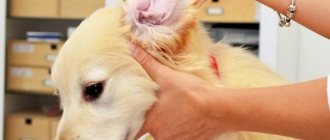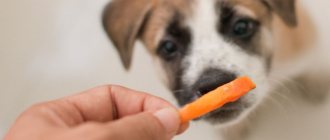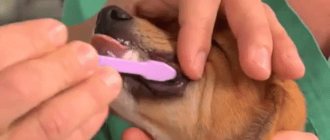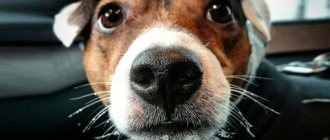Benefit
For the first time in their lives, dogs are introduced to massage in infancy. When a mother licks her newborn puppies, she helps them breathe. When the cubs grow up, the mother kneads their tummies. This manipulation prevents constipation.
Massage for dogs is also necessary in adulthood. This is a good means of treating and preventing diseases. The benefits of massage treatments are as follows:
- Massaging movements stimulate blood circulation. As a result, blood flows to a certain area of the body, tissue nutrition and local metabolism improves. This promotes faster healing of injuries, which is why massage is often prescribed for injuries.
- The procedure stimulates the motor nerves. Therefore, massage is necessary for paralysis and weakness of the paw muscles. This rehabilitation activity helps restore movement.
- Massage helps to relax and calm the nervous system. This procedure is useful for a dog after experiencing stress, difficult training or an exhibition.
- Massage procedures improve peristalsis and facilitate easy bowel movements.
In many cases, dog massage can be done on your own. However, if your pet is seriously ill, the procedure should be performed by a professional. Not all types of massage treatments can be done at home.
Benefits of massage for dogs
When a puppy is just born, the mother licks it, stimulating breathing. This is his very first massage. Then the mother kneads the baby’s tummy to make it easier to go to the toilet after eating. Four-legged animals can and should be massaged in adulthood, this will help cope with many diseases or avoid them. How is massage beneficial for dogs ? Massage allows you to:
- improve blood circulation. Blood flows more strongly to the area that is stimulated by massage movements. Due to this, the tissues are saturated with oxygen. If you do this periodically, your metabolism will improve and the skin in this area will regenerate better. Useful for injuries;
Massage improves blood circulation and overall well-being of the dog
- increase tone. Thanks to this, the animal maintains healthy muscles and bones. Massage movements stimulate the production of histamine in the subcutaneous tissue. Due to this, the blood vessels dilate and an analgesic effect appears;
- provide stimulation of nerve tissue. Because of this, sensitivity improves and pain disappears. Regular massage can help restore mobility to a paralyzed pet. You can read more about massage for dogs whose hind legs are paralyzed in a separate article on our portal;
Massage has a positive effect on the dog's condition
- strengthen the body and provide relaxation. Helps calm a nervous pet, relieve spasms, relieve stress;
- helps with constipation. Peristalsis improves and bowel movement becomes easier;
- detect a tumor at an early stage. By constantly feeling the animal’s body, pathologies, such as cancerous tumors, can be diagnosed early. You will be able to contact a veterinarian in time and cure the animal;
- rehabilitate after injuries. In this case, a therapeutic massage for dogs is prescribed by a veterinarian, and it is done in a special way.
Therapeutic massage will help your dog recover from injuries
Indications
For what diseases is massage for dogs indicated? This procedure is effective for the following pathologies:
- diseases of the musculoskeletal system;
- injuries;
- constipation;
- inflammation and degeneration of joints;
- pain syndrome of various origins;
- neurotic disorders.
Healthy dogs should also get massages regularly. This will help your pet maintain a healthy musculoskeletal system into old age, as well as relieve stress and relax.
Contraindications
There are times when massage is contraindicated. This procedure should not be done under the following conditions:
- fever;
- any injuries and lesions of the skin (eczema, tumors, wounds, pustules);
- bleeding;
- fresh bone injuries with severe pain;
- epilepsy;
- severe liver and kidney diseases;
- shocked.
If your dog has at least one of the listed contraindications, then refuse massage. Otherwise, the treatment procedure will do more harm than good.
Some tips
Before giving your dog a massage, check out the following advice from veterinarians:
- You will need a basic knowledge of canine anatomy and physiology. You can learn about the characteristics of the animal’s body from a veterinarian. You can also find this information yourself on dog breeding websites.
- During the procedure, turn your pet over to massage first one side and then the other. Try not to press on the stomach; this part of the body can only be lightly stroked. Otherwise, the abdominal organs may be damaged.
- If your pet is diagnosed with a serious illness, then it is better to entrust massage treatments to a specialist.
- If you give a preventative massage to a healthy dog, then the procedures should be regular. Try to spend at least 10 minutes on this every day. This will be a good prevention of the development of arthritis.
- If your pet is healthy, then pay attention to its reaction to the procedures. If the dog shows dissatisfaction (growls, flinches), then do not force it. You need to gradually accustom your animal to massage.
Adviсe
An owner who wants to learn how to massage their pet should familiarize themselves with some basic recommendations:
- Before starting manual therapy, learn the basics of canine anatomy and physiology. You can research this yourself online or ask your veterinarian;
- Spend 10 minutes daily massaging a healthy dog. This way, her muscles and joints will remain in good condition - in old age there will be no problems with limb atrophy or pain. She will also be happier and more content;
- First, crumple one side of the pet, then transfer it to the other. Do not touch the stomach at all or just stroke it lightly - otherwise you can damage the internal organs;
Abdominal massage should be done last.
- If the dog is seriously ill, contact a professional massage therapist. In this case, you need to take the matter responsibly;
- Do-it-yourself massage is good, but you still need a veterinarian. Take your dog regularly for examinations in order to detect serious diseases in time if they arise;
- If your dog doesn't like the procedure you're doing as a preventative, don't force it. You will immediately notice if something is wrong - the animal will growl, hold its breath or begin to shudder.
We do a general massage
Veterinarians recommend general massage to prevent disease. The methodology for carrying it out is as follows:
- Cover a hard surface with a soft cloth. Place your pet on it and stroke it from head to back.
- Massage the back first with your fingers and then with your palms. Gently knead the skin, trying not to put pressure on the spinal column.
- Focus on the sacrum. Massaging this area prevents joint diseases.
- Rub your paws from top to bottom. Then bend and straighten each finger.
- Gently pat your pet's belly. At the same time, avoid sharp pressure.
- Now move on to massaging the muzzle. Take the cheeks with your fingers. Lift them up and then lower them down. Stroke the chin, as well as the area around the nose and eyes.
Complete the procedure by stroking the tail from base to tip.
Relieving pain
How to massage a dog if something hurts your pet? The procedure technique is as follows:
- Place the dog on a blanket or the floor, make petting movements and talk to the dog in a soft voice.
- Rub your shoulders, neck and back in circular motions, as if you were kneading dough. Do not put too much pressure on your body, as this may increase the pain.
- Gently stretch your paw muscles. Move from their base down. Don't forget to massage your fingers.
- Direct impact on the source of pain is prohibited. You can only stroke and knead the muscles around the sore spot. This will help improve blood circulation and reduce discomfort. Be especially careful if your dog suffers from cancer. Try not to touch the tumors, this may provoke their growth.
- Complete the procedure by lightly stroking the entire body from head to tail and each paw.
Helping the dog relax
A relaxing massage for dogs is essential to calm the nervous system and relieve stress. This procedure is useful to do when your pet is frightened by something or after a hard day. In this case, the main attention should be paid to the area of the head, ears and back.
Follow the following sequence:
- Pet your pet's entire body. At the same time, try to speak kindly to the dog. Pat the dog by the scruff of the neck. This will help the animal calm down and relax.
- Start the massage from the neck. Massage the area in a downward circular motion. Do not press too hard, remember that there are many blood vessels in this area. Massage the ears and the area around them, but very gently.
- Then move to the shoulder girdle. Make the same circular movements. Gradually move towards the tail.
This completes the procedure. Finally, you can stretch the ponytail a little or turn it three times in different directions. But watch your pet's reaction. Some dogs find such manipulations relaxing, but not all dogs like having their tail touched.
Why massage your dog?
Animal massage began to be used in ancient India. According to the simplest definition, it is rubbing and kneading the muscles and joints of the body with the hands to relieve tension or pain.
Dog massage can be used at home:
- for relaxation and stress relief;
- relaxation of spasming muscles;
- reducing tissue swelling;
- improving blood circulation;
- joint healing;
- relief of arthritis;
- accelerating the regeneration of muscles, joints and bones.
| Main reasons for the procedure | Peculiarities |
| Anxiety | Contact with the owner is especially important and useful for reducing stress during:
|
| Arthritis | Gently rubbing and kneading increases blood circulation. Hand pressure causes tissue contraction and increases blood flow in this area of the body. Be careful not to press too hard. Stop if the dog flinches, walks away, bites or growls. |
| Warming up the muscles | Just like athletes, massage helps dogs stretch their muscles before training or competition. This procedure:
|
| Post-activity | Age, overexertion, prolonged periods of inactivity during treatment, or injury can lead to muscle congestion, stiffness, and pain after exercise. A massage session helps to cope with this discomfort. |
Canine massage is prescribed by many veterinarians to aid recovery after surgery. In this case, it is part of physiotherapy and is needed to restore the full functioning of the limbs.
Important! Remember, massage does NOT heal an injury. It relieves pain, relaxes muscles and helps tissue repair.
General benefits for the body
By licking the puppies, the mother dog stimulates the movement of blood and other fluids, ensuring the development of muscle tissue. To ensure that the intestines work properly, she licks their bellies. In the future, the puppy will take care of his own appearance, but he will still like to be stroked or scratched behind the ear.
Massage for older dogs:
- improves tissue functioning and reduces the need for medications;
- improves blood circulation and helps lower blood pressure;
- strengthens the immune system;
- helps digestion;
- stimulates the functioning of the kidneys and liver;
- provides a full, eventful life.
For dogs with high physical activity, athletes and service pets, therapeutic massage will improve blood flow, providing conditions for rapid tissue healing after injury. As adhesions are reduced, the restored limbs will move better and the likelihood of arthritis and pain will be minimal. After the session, the person feels renewed, and the dogs experience the same sensations.
For a nervous and restless dog that has suffered trauma or been surrendered to other owners, this is a way to relieve tension. It helps the animal relax and calms its nervous system. In addition, massage also strengthens the relationship between pet and owner.
Massaging the limbs
Massage of the hind legs of dogs is done for paralysis and weakness of the muscles of the limbs. This procedure is an important part of rehabilitation. It stimulates nerve endings and develops muscles. This helps restore normal limb mobility.
To achieve the desired effect, your dog's paws must be massaged regularly. Treatment should continue for at least 20 minutes a day. To achieve the result, about 20 procedures will be required. Then they take a break for 14 days and repeat the sessions.
How to massage your dog's paws? It is necessary to give preference to kneading and vibration effects. This helps stimulate and restore nerves and muscles.
Use the following massage technique:
- Pet the dog's entire body. Try not to lift your hands while doing this. Your pet should be completely relaxed and calm.
- Gently pat the paw. Move from the base to the heels. Then slowly bend and straighten the limb. Repeat this movement 5 times.
- Massage your paw in a circular motion. First move to the inner surface of the limb, and then to the outer. Repeat the massage movements three times.
- Rub your paw muscles well. Gradually increase the intensity of the impact, but do not overdo it. Gently massage your heels and spaces between your toes.
After massaging one paw, move on to the other. Using this technique, you can massage both the hind and forelimbs. If you repeat the sessions regularly, your paws will regain strength. Gradually, your pet will learn to walk again.
Source
How to massage a dog: algorithm for different types of procedures
Relaxing and therapeutic massage treatments are recommended not only for people, but also for pets. With their help, you can relieve muscle pain and even improve the functioning of the gastrointestinal tract. If you don’t know how to massage dogs, then you don’t have to constantly go to a veterinary clinic for this service. With enough practice, you can master the technique yourself.
Types of massage for dogs
Veterinary clinics create individual massage programs, depending on the pet’s health status, breed, and weight. But the most common types are:
Therapeutic and health massage for dogs, which is given to animals with arthritis, arthrosis, osteochondrosis, dogs after fractures, sprains, hematomas, dislocations.
Preventative is performed using various techniques in order to relax the muscles and increase their tone. For example, dog athletes receive a warm massage to relieve muscle tension.
Rare, but provided in some pet salons, is aquamassage for dogs. This procedure is considered therapeutic. Boiling water has a healing effect. The animal is placed in a small bath with hot bubbling water, the water streams have a relaxing effect on the muscles, aqua massage increases tone, increases the mobility and elasticity of the joints, and improves blood circulation.
In spa salons, animals are given massages using cosmetics , in particular aromatherapy. Cosmetics, such as sea salt, fortified powders, aromatic oils, are applied to damp hair and rubbed in with light movements. Then the cosmetics are washed off with water. The products strengthen and add shine to the coat, relieve static tension, and normalize blood circulation.
Some techniques are aimed at correcting a dog's behavior , for example, making the pet calmer and getting rid of the habit of barking and gnawing.
When is massage indicated for a dog?
The procedure is carried out for therapeutic and preventive purposes. In the first case, it is prescribed in the presence of the following pathologies:
Nervous disorders
. Massage actions relax the body, calming the nervous system. This helps to cope with stress and exciting events.
Various pain syndromes
. Thanks to the stimulating effect, histamine production in the subcutaneous tissue improves. All spasmodic vessels dilate, so existing pain subsides or disappears completely.
Injuries
. Stimulation of blood circulation improves metabolism, accelerating the regeneration of damaged tissues.
Constipation
. The technique used improves intestinal motility, facilitating bowel movements.
Diseases of the musculoskeletal system
(joint degeneration, paralysis). Stimulation of motor nerves and strengthening of muscle tissue make it easier for a sick animal to move, helping to restore lost function.
How to massage a dog
The procedure is carried out in pet salons, veterinary clinics or at home. There are many advertisements on the Internet from private massage therapists who come to your home and perform the procedure in the conditions familiar to the animal. You can massage a dog yourself; anyone can learn how to do this, as there are many training seminars and manual therapy courses.
In a pet salon or veterinary clinic, massage is done on a table or on the floor on a soft mat. The dimensions of the table should be such that the animal can lie down comfortably with its limbs stretched out. During the procedure, the presence of the owner is allowed, because this way the animal feels calmer. As mentioned earlier, aggressive dogs must be muzzled.
Regardless of whether a massage is performed for preventive purposes or for medical reasons, it always begins the same way - with establishing contact. They make it clear to the animal that they will not do anything terrible to it, they try to calm it down by stroking and scratching, and carefully identify the more sensitive and unpleasant areas to touch.
After the dog trusts the specialist, relaxes and takes a comfortable position, the massage begins. The intensity of pressure on parts of the body depends on the health of the animal, for example, in case of muscle tears, swelling, hematomas, increased sensitivity of certain parts of the body, massage is done with light movements of the fingertips.
Preventive massage lasts 10-20 minutes, therapeutic and wellness massage can last up to 30 minutes. However, to achieve the goal, a course of massage is required; usually 1 session does not give the desired result, although the dog is already beginning to feel better. After the procedure, the dog may be lethargic or sleepy, which is quite normal after relaxation.
Types of massage
Depending on the goal being pursued, several techniques are distinguished. They can be divided into 3 large groups:
Relaxing
. Suitable for relieving nervous tension and deep relaxation. All actions performed are focused on the spine area.
Preventive
(wellness). Aimed at improving muscle tone and increasing the elasticity of joints and ligaments. This type is suitable for preventing chronic diseases and maintaining overall health.
Medicinal
(rehabilitation). This group includes all varieties recommended for recovery after operations, injuries and diseases of the musculoskeletal system. With their help, the animal returns to its normal life.
Separately, it is worth highlighting the cosmetic appearance offered in grooming salons. It is a combination of a complex of care procedures and relaxing massage movements.
All of the above techniques can be performed at home. The only difficulty may arise with hydromassage, a type of medical procedure. It is carried out only in a limited number of veterinary clinics equipped with a special bath for ozone therapy.
Spa treatments and massage for dogs
What are the benefits of Spa treatments for me and my dog?
Spa is a philosophy of relaxation, a special delicate attitude towards a person, and not just cosmetic and health procedures. Its synonyms are pleasure, peace, bliss, salvation. Salvation from constant stress, lack of physical activity, unhealthy diet, crazy pace of life and aggressive ecology, which every day poisons our lives with polluted air, noise and other influences.
SPA magic is a salvation from chronic fatigue, from depression and wrinkles ahead of schedule, from various well-being disorders to which a resident of a metropolis is susceptible, and regularly.
But your dog experiences no less stress during his life than you and all the other residents of the big city. Of course, you won’t see wrinkles from stress on his face, but dull, matted hair, sometimes falling out more intensely than usual, lets you know that your dog is not feeling very well. But now, in addition to the usual regular care (proper feeding, walks, sufficient exercise, grooming, regular veterinary examinations), your dog has a unique and excellent opportunity (like people in spa salons) to get a boost of health, improve well-being, and relax .
After all, the programs developed in our salon will really help your pet:
Firstly,
- improve coat,
- nourish it with vitamins,
- add shine,
- stimulate growth.
Professional cosmetics refreshes, renews, nourishes, moisturizes, tones the skin and coat, makes the coat silky, leaving it well-groomed and shiny.
Secondly,
Relax your pet with a massage. Massage for dogs significantly increases their level of vital activity, giving the dog the opportunity to feel that you love it and care about it. A relaxing bath will help relax and warm up your dog's muscles.
So, in one procedure your dog will receive:
- massage,
- relaxing bath,
— a refreshing and toning mask for the coat,
- wool restoration.
We have several spa treatment programs with recommendations for use, which you can familiarize yourself with, and most importantly, purchase a subscription for your pet.
And the dog will definitely tell you - thank you very much, owner!
Your dog has the opportunity to try special programs in our salon aimed at improving coat and increasing immunity. Our masters will help you solve problems with your pet’s coat, improve tone, improve health and give your dog pleasure. Professional cosmetics refreshes, renews, revitalizes, nourishes, moisturizes and tones the coat and skin, makes the coat silky, leaving it well-groomed and shiny. We offer the following treatments: — Massage — Relaxing baths — Refreshing and toning masks — Hair restoration
1)Massage with oil + restorative mask “MINT WITH VITAMIN B6”.
Dog massage + restorative mask is carried out using the following components: Ginko Biloba oil extract - a unique product for skin regeneration, helps restore hair and skin cells, making them strong, flexible and elastic. It is a natural anti-inflammatory that helps regulate sebaceous secretions. Promotes relaxation and improvement of muscle tone, strengthens blood vessels. The restorative mask nourishes, moisturizes, tones and restores the skin and hair, makes the coat shiny, and gives it a well-groomed appearance. The refreshing properties of mint essential oils are combined with the protective and strengthening effects of vitamin B6. Mint cools the skin and, together with its aroma, prevents the appearance of fleas and other blood-sucking insects.
How does a dog massage + revitalizing mask work?
Initially, the groomer will wash the dog thoroughly (for this, professional cosmetics for dogs are used). Then the master mixes the above components in certain proportions to obtain a gel-like liquid, which he applies to the washed dog. Massages the dog's entire body for 10 - 15 minutes. Then rinse thoroughly with water. Then blow dry. This Spa procedure is over.
2) Oil massage + Cleansing mask based on Dead Sea clay.
Oil massage + Cleansing mask is carried out using the following components: this Spa procedure begins with the master initially thoroughly combing the dog. Then he moisturizes the hair with fortified water, then, using massaging movements, evenly applies a natural clay mask to the dog’s body and coat (it penetrates the hair follicle, cleanses the hair from the inside, nourishes it and strengthens it, gives the coat a special shine and a natural healthy appearance, acts as a soft peeling on the skin ) + Ginko Biloba oil extract (a unique product for skin regeneration, helps restore hair and skin cells, making them strong, flexible and elastic. It is a natural anti-inflammatory agent that helps regulate sebaceous secretions. Helps relax and improve muscle tone, strengthens blood vessels .) The groomer should then wrap the animal in a towel and let the extract sit for 7-10 minutes. After this, the master performs a massage for 8-14 minutes. Next, he washes the dog with shampoo and completes the procedure by applying conditioner. Dries the dog with a hairdryer. This completes the massage.
3) Mineral bath based on “Tonic tablets”.
Relaxing tablets, which have a healing and toning effect, close the pores of the skin. Minerals and salts help cleanse and increase blood circulation in the skin, and have a beneficial effect on the entire body as a whole. The product invigorates, relieves stress, is effective during shedding and after illness, leaves the coat shiny, healthy, and smelling good.
Recommendations for use:
- after significant hair loss and seasonal shedding; - after severe stress; - for itching and irritation of the skin; - with increased oily skin; — after stripping, trimming and cutting;
We apologize, the service is temporarily NOT PROVIDED.
Are there any contraindications?
Like any medical procedure, massage for dogs has a number of contraindications. These include the following conditions:
any skin lesions (neoplasms, open wounds, inflammation, ulcers, eczema);
fresh fractures with severe pain;
acute or advanced kidney and liver diseases;
epilepsy or shock.
Please note that even in the absence of the listed contraindications, you should consult a veterinarian before starting home sessions. He will not only select a more effective technique, but also explain its main nuances.
Contraindications to massage
It is important to remember that this is a medicinal thing, so it has contraindications. These include:
- eczema;
- purulent infections;
- neoplasms;
- open wounds;
- increased body temperature;
- bleeding;
- epilepsy;
- inflammation;
- state of shock;
- fresh fracture with pain.
Be sure to consult your veterinarian before performing a massage.
Attention! If you have at least one item from the list, do not touch your pet! Even if there are no contraindications, it is still advisable to consult with a veterinarian before starting sessions - he will tell you what exactly is right for your animal and teach you the basic techniques.
Techniques for different types of massage
The massage movements used for four-legged pets are softer. Excessive force can cause harm, so it is important not only to time your efforts, but also to understand the peculiarities of canine physiology and anatomy.
Despite some differences, all available types involve the following hand movements:
strokes that relax the body;
fingertip tapping to help warm up the body at the very beginning;
twisting, kneading tissue under the skin;
rubbing, increasing blood flow and eliminating adhesions;
compression (shaking) to relieve muscle spasms.
To obtain the desired results, you must devote at least 10 minutes to the procedure every day. At first, you should choose the minimum time to allow the animal to get used to unusual actions. If dissatisfaction appears (trembling, growling), it is recommended to stop the session.
Relaxing
First, prepare a flat surface by covering a table or regular floor with a soft cloth. You can put a muzzle on an aggressive pet, but you still shouldn’t abuse this accessory for a long time. Your pet should enjoy the session, so do not force him against his will.
After preparing a comfortable place, use the step-by-step algorithm that explains how to massage dogs:
Start with light strokes. Use your fingertips and the inside of your palm to move around your entire body. Scratch the scruff of the neck and be sure to praise your pet so that he feels safe and as relaxed as possible.
Massage your neck in a circular motion, moving from top to bottom. Perform all movements smoothly so as not to damage the vertebrae.
Knead your ears and surrounding area. Be careful. The area between the ears is especially sensitive, as there are many nerve endings there.
Using similar circular movements, stretch your shoulders and rotate the ponytail around its axis three times in different directions.
Complete the procedure by stroking, moving from the back of the head to the tail.
Despite interaction with a rather limited number of areas (ears, withers, back, tail), relaxation occurs throughout the body. This occurs thanks to the neurons of the spinal column, which transmit signals even to the most distant areas.
Anesthetic
The technique for performing this type is similar to a relaxing massage for dogs, focusing on the back. The only difference is that the working area will depend on the location of the source of pain.
Use stroking, rubbing and light twisting, but do not directly affect the source of pain. You should also avoid contact with existing tumors. Stimulating blood circulation can affect their growth.
If your pet's paws hurt, use the tips recommended for paralysis. In other cases, you can adhere to the relaxation technique algorithm.
Medicinal
The technique for performing this type depends on the problem at hand. It is prescribed for constipation, paralysis, recent stroke, mastitis, dysplasia, arthritis and other pathologies.
How to properly massage a dog
There are many massage techniques.
But there are 3 main ones that will help your dog improve its health:
- effleurage is long, smooth strokes; do them at the beginning and end of sessions; this helps to warm the tissue;
- kneading and twisting of skin and tissues - performed to remove adhesions and massage tissues under the skin;
- compression – used in a “pumping” motion to help the fibers under the top layer of skin; it is used to relieve muscle spasms and improve blood circulation.
There are other techniques used, but the three main ones are what you need to know to do a home massage session correctly.
Relaxing
Massaging a dog is not the same as massaging a human. These are too rough movements that can damage the health of the pet. Relax the muscles with soft circular movements.
Relaxation massage technique:
- Make sure the animal is calm. If the dog is scared, the session will only increase its negative state.
- Start with gentle stroking and gentle conversation.
- Massage your neck in circular motions. Press gently.
- Continue massaging down to your shoulders. Since the dog cannot reach its withers, pay special attention to this area.
- Move along the sternum to the front legs.
- Be careful when massaging your fingers. Many dogs have an automatic kick reflex if something touches the area between the pads on their feet.
- Massage your back in a circular motion, moving up and down on both sides of your spine.
- Continue kneading until you reach the tail.
Important! When performing
a massage, pay attention to your pet's reaction. If he is in pain, he will flinch when you touch such an area.
How to do therapeutic massage
Rehabilitation (therapeutic) massage is performed only if it is recommended by the veterinarian who is observing the dog. In this case, the massage technique depends on the type of injury and is chosen in order to speed up tissue restoration and healing.
For paralysis of the hind or front legs
Physical therapy for paralysis is designed to help your pet regain lost walking abilities. It is difficult to predict in advance whether the functions of the hind limbs will be restored, but you can try to help. The duration of the rehabilitation period is about 2 years.
If the paralysis is caused by fibrocartilaginous embolism, restorative massage begins immediately. During surgical intervention - only from the moment the doctor allows it. Until then, it may be suggested to keep the dog in special orthopedic accessories.
Here are the main therapeutic exercises:
- "Bike". You need to move your legs alternately for 5 minutes 2 times a day - morning and evening. You need to keep your legs flexible.
- Stimulation of the circulatory system. Rub your paws, tickle between your toes. This needs to be done several times a day - up to 10. After paralysis, the body needs to reassign the path from the brain to the fingers, and the more you stimulate the feet, the faster the reflexes are restored.
- Foot massage. Performed once a day to improve blood circulation. Use kneading and rocking movements.
- Scratch. Run your nail along the paw to find the sensitive spot. In response to touch, the pet will twitch its paw (or try to do so).
- Exercises with the ball. Place the dog on the ball, hold it with your hands and roll it along the floor. The paws will take 2 positions - resting on the ground and hanging in the air. Instinct forces the paws to try to find support on the floor. In this way, muscles and ligaments are trained, the pet does not lose coordination of movements and trains endurance.
- Jumping (for not very large dogs). Hold your pet by the front part of its body under its paws. Lower the rear ones until they rest on the floor, and then lift them up. The exercise can be done once a day in the morning, gradually increasing the number of approaches - up to 5-7.
Important! The position of a dog with paralyzed limbs needs to be changed every 4
–
6 hours to avoid bedsores. Bedding should be level, because areas where pressure is applied unevenly will begin to suffer from poor circulation.
For injuries
When a part of the body is injured, scar tissue forms as it heals. The blood supply in this area deteriorates, the muscle does not move enough, thickens, becomes shorter and weaker. This causes pain and can cause re-injury. In this case, massage for dogs is aimed at restoring blood supply to the area and kneading the resulting scars.
Basic method:
- Place your pet on a flat surface.
- Start with strokes and kind words. Smooth from neck to tail. Time - 1-2 minutes.
- Move your hands in a circular motion along the area to be stretched. Mark all pain points. As you work further, try not to touch them.
- Where the pet does not experience pain, massage with kneading movements. Time - about 5 minutes.
- Finish with a general gentle stroking of the animal.
Lymph nodes are located just under the skin in the fatty tissue near the flexor parts of the joints. When you swing your arms or bend your limbs, you create pressure on the fluid, causing it to move.
Lymphatic drainage massage technique:
- Place your pet on a flat surface.
- Pet him and soothe him with your voice.
- Start by relaxing. Then take the limb with the swollen lymph node and slowly bend it at the joint. You need to understand how much this place is swollen.
- Use rocking to warm up the muscle.
- Work the area with soft stroking movements. The liquid inside moves in the direction set by the hand. Exposure time is about 4-5 minutes.
For the back and spine
Most dogs are trained to receive back pats. This is one way to thank your pet for a job well done. Here are a few techniques that can be applied to it while sitting or lying down.
Flat hand massage is a relaxation technique used to calm your dog. These are long, gentle movements that gently stretch the skin and muscles. If you have sensitive hands, pay attention to cold and hot areas of the skin. They are a sign of poor blood supply and these places need to be given attention during the session. Also pay attention to the quality of the coat: you may notice signs of excessive hair loss, then a massage will help start treatment in time.
Flat hand technique:
- Place your hand on the dog's chest. It's a calming gesture. Keep your fingers together and your hand flat, like a mitten.
- Now move it to the withers. Press against the body, applying even pressure with the entire plane and fingers.
- Move your hand to the tail.
- Repeat the movements for the spine and adjacent muscles at least 5 times.
- If your pet shudders, make an appointment with the veterinarian, as this is a sign of muscle spasm or problems with the musculoskeletal system.
Cross-fiber massage is applied after the previous technique. This is the movement of the fingers back and forth on a specific area of the body. The palm remains wide open. Its purpose is to improve blood circulation and unblock muscle spasms.
Cross-fiber massage technique:
- Start the movement by lowering your hand 3 cm below your shoulder blades. Place your hand on your back.
- Straighten your fingers and grab the muscle area. Squeeze your fingers towards your palm.
- As soon as your “fingers reach” the spine, slowly unclench.
- Repeat on each section 2-3 times.
- Pay attention to the condition of the muscle. It should be soft. If not, then this area will need to be developed.
Did you know? A dog can find the source of a sound in 1/600 of a second and hear sounds at a distance 4 times greater than a human can.
Indirect cardiac massage
Indirect cardiac massage is the first aid that can be provided to a pet in case of cardiac arrest. This situation is possible as a result of electrical injury. Before doing anything, assess the pet’s condition. Press the back of your hand or cheek to your nose and try to sense the movement of air. If the dog is not breathing, check the airways for blockages. Pull out his tongue and make sure nothing gets into his throat (foam, vomit).
Feel the pulse on your inner thigh at the point where your leg meets your body. There should be a pulsation there. If there is no pulse, then begin resuscitation. The heart is on the left. Place your pet on his right side and bend his front left leg until his elbow touches his chest. The heart is located at this point.
Heart starting technique:
- Place both palms, one on top of the other, on top of the widest part of the chest, near the heart, but not directly above it. For a small dog, wrap your arms around the chest, placing your fingers on top of each other.
- Apply firm, quick compressions to the sternum. Squeeze 1/4–1/3 of your chest, no more. You need to do 15 compressions in 10 seconds. For small dogs - 17 compressions in the same time.
- Give artificial respiration after each set of compressions. Place your hand on the dog's face and make sure the mouth is completely closed. Touch your lips to your nostrils and gently blow air, making sure your chest rises and expands. If the chest is not understood, blow harder. One breath should follow every 2-3 seconds. Constant speed - 20-30 breaths per minute.
- Place your left hand under your pet's belly and your right hand on top. Press down to compress the abdomen and help circulate blood back to the heart.
- Do one abdominal compression after each set of 15 compressions and one breath.
- Continue until the dog begins to breathe. If 20 minutes have passed and breathing has not resumed, then it is unlikely that you still have a chance to bring your pet back to life.
It is prohibited to use resuscitation on a living and healthy pet - this can harm it. But knowledge of such a technique may help save his life.











